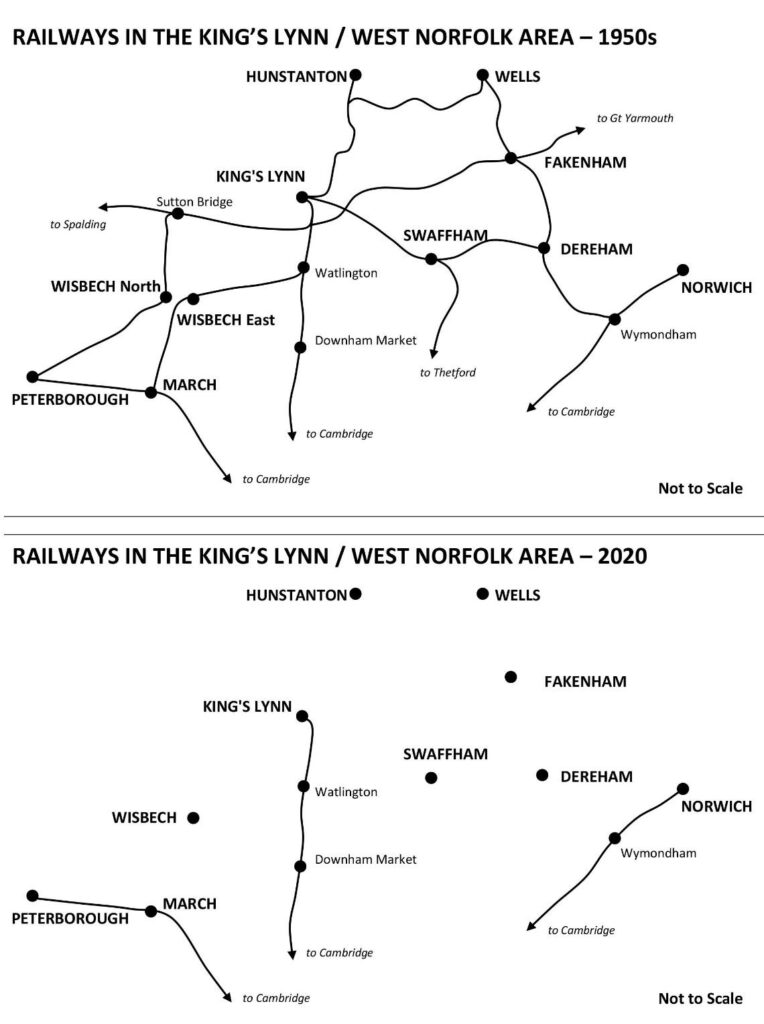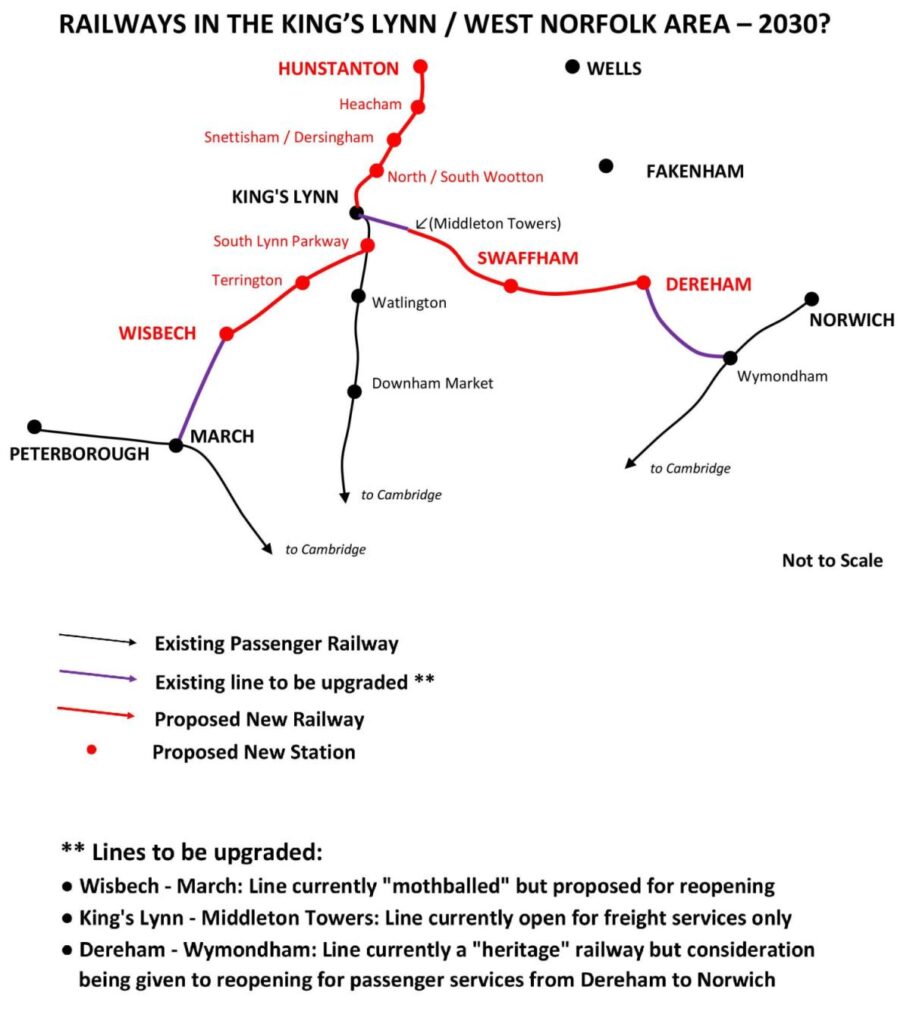and/or … how can we create a carbon-neutral transport system for West Norfolk?
There has been a seismic shift in attitudes to rail transport in recent years — with both policy decision-makers and the general public embracing the idea of bringing back a more comprehensive rail network. And with good reason. An increased railway network could offer an important element of a ‘low carbon’ transport system of the future.
To achieve the urgent reduction in carbon emissions required to halt global warming, changes to our current transport ‘culture’ are essential. Transport accounts for around a third of all emissions in the UK — the largest contributing sector. The great majority is from road-based traffic. How can this be reduced?
Electric vehicles (EVs)
The Government have now said there will be no new petrol or diesel cars sold after 2030. Many people seem to think that electric vehicles will be a quick fix to all of our environmental problems — but this is doubtful.
Some have calculated a battery-driven car takes twice as much energy to manufacture as a petrol car. The materials for batteries are expensive, finite and complicated to recycle. Millions of electric cars will still cause air pollution (both in manufacture and use). Millions of electric cars will still cause congestion and require more road building.
A critical factor for many people will also be the cost of EVs. At present, they cost at least twice as much as a new petrol/diesel car. Relative manufacturing costs should drop and it is clear that electric cars appear to be much cheaper to run. But this means that the car industry will not make money from ongoing maintenance — they will need to make their money at sale.
This is likely to sustain a relatively high purchase cost. Meanwhile, many analysts think that the relative average wealth of UK citizens is likely to drop in coming decades. We need to consider how the average household can become less dependent on private car ownership.
Other public transport, cycling and walking
Making cycling and walking more attractive ways to travel and investing in zero-emission public transport is part of the Government’s 10-point plan for a ‘Green Industrial Revolution’ (announced in November 2020).
Cycling and walking are being strongly encouraged partly for local journeys, but also for general health and wellbeing. Some UK retailers have reported sales of electric bikes rising by 60% in 2020. Both Norfolk County Council and the Borough of King’s Lynn and West Norfolk are working on plans to improve pedestrian and cycle networks. But for longer journeys, other forms of transport will be essential for most people.
Electric or hydrogen-powered buses and taxis will be another important opportunity to reduce the carbon emissions of transport. But these vehicles will still join other transport on already congested roads. This may be one reason why the popularity of bus travel has waned over time — the number of bus users falling by 62% since 19601. (In this same period, despite drastic cuts to the rail network, the number of journeys by rail rose by 170%.)
1 DfT Transport Statistics for GB — published 2019
Replacing lost rail links
The UK railway network took over 100 years to construct and a couple of decades to decimate. After 1945 Government policy was firmly orientated towards road building and private car ownership. An estimated 5,000 miles of railway and 2,300 stations were closed, with 3,500 miles of railway closing in just 14 years between 1948 and 1962. (For comparison — consider that today, after more than 60 years of road building, there are just over 2,100 miles of motorway in the entire UK!)
East Anglia and Norfolk were particularly hard hit. See the plans below of 1950s rail links in West Norfolk compared to what we have now.
It is now recognised that the cuts not only undermined the functionality of a whole transport system, but led to towns and large rural areas becoming peripheral communities, with poor connectivity and related inequalities.
A future rail network for King’s Lynn and West Norfolk?
Utilising existing protected sections of former railway track and upgrading short sections of existing, partially-used railway, a new network for West Norfolk could quickly provide enhanced connectivity with major centres such as Cambridge, Peterborough and Norwich.
A restored railway network could underpin the decarbonisation of commuter, tourist, and freight transport whilst providing opportunities to level-up communities that have suffered from many decades of ‘peripheralisation’. Together with other forms of low-carbon public transport, and a greatly improved cyclepath and footpath network in our settlements, it is realistic to imagine a future where car ownership could be optional for many households.
We think reopening the Hunstanton railway could be a key component in a more sustainable transport system for West Norfolk. Not only could it provide a fast, reliable service for local residents, but it could also remove thousands of holidaymaker vehicles from our roads. Re-connecting King’s Lynn docks to the railway would be another way of reducing road freight in Lynn.
Sustainable settlement expansion
New rail links and rail stations could also provide a more sustainable model for urban expansion plans. Currently many of our settlement growth plans look set to increase road congestion through the provision of car-dependent settlement planning. Even with a massive switch to electric vehicles, these ideas seem unlikely to support a cultural shift to the ‘multi-modal’, carbon-neutral transport approach that we need.
There is a great opportunity for a ‘Parkway’ station in South Lynn. Not only would this help to reduce traffic entering the town to access the current station, but it would also benefit the major new urban growth planned at West Winch and North Runcton. It would be a short cycle or walk from the proposed NORA Enterprise Zone and potentially of benefit for other local employment sites.
A South Lynn Parkway would also be an ideal junction point for trains to Peterborough. Former lines (shown dotted pink on the aerial photograph) could be used to provide dedicated cycle and pedestrian routes to the new station.
A more formalised diagram of the proposed rail infrastructure is provided below.



